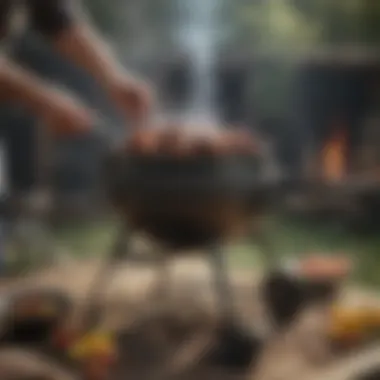Comprehensive Exploration of Weber Grills and Smokers


Intro
Weber grills and smokers have become synonymous with outdoor cooking excellence. This article aims to dissect the various facets of these culinary appliances. From the essential features that set Weber apart, to the finer points of maintaining and using them effectively, we will provide a comprehensive exploration that appeals to both beginners and seasoned cookers. Grilling and smoking are not merely methods of cooking; they are art forms that can elevate an ordinary meal to extraordinary heights.
In the following sections, we will discuss the distinct types of grills and smokers available under the Weber brand, highlighting their functionalities and best practices. By the end, you should have a nuanced understanding of how to enhance your grilling and smoking experiences with Weber, hopefully inspiring you to embrace these techniques in your own culinary endeavors.
Understanding Weber Grills
Understanding Weber grills is fundamental for anyone interested in enhancing their cooking skills. These grills are not just cooking appliances; they represent a lifestyle choice for many culinary enthusiasts. Weber has a long history that ties innovation with quality, making their products a cornerstone in outdoor cooking. This section will explore the historical background, various types, and key features that make Weber grills a preferred choice.
Historical Background of Weber Grills
The origins of Weber date back to 1952 when George Stephen, a welder and metal worker, invented the first kettle grill. This innovation introduced a new method of grilling by enclosing heat, allowing for better cooking control. Over the decades, Weber has continuously evolved its product line to include various models catering to different grilling preferences. This history is essential to appreciate the brand's commitment to quality and performance in outdoor cooking.
Types of Weber Grills
Weber grills come in several types, each serving different cooking needs and preferences. Knowing these can help users make informed choices based on individual requirements.
Charcoal Grills
Charcoal grills are perhaps the most traditional form of grilling. Their primary appeal lies in the ability to produce distinct flavors that many enthusiasts crave. These grills rely on charcoal briquettes or lump charcoal, which provide high heat and smoky flavor. The key characteristic of charcoal grills is their ability to reach high temperatures. This can contribute to the ideal environment for searing meats. Nevertheless, they face some disadvantages, such as longer setup and cleanup times.
Gas Grills
Gas grills have gained popularity thanks to their convenience and ease of use. Powered by propane or natural gas, these grills provide consistent heat with minimal waiting time. Their key characteristic is the ease of temperature control, allowing for a quick switch between high and low heat. This immediacy makes them favorable for those who enjoy frequent grilling sessions. One potential downside is that some users feel that gas grills lack the authentic grilled flavor found in charcoal grilling.
Electric Grills
Electric grills cater to individuals with limited outdoor space or those who live in areas with grilling restrictions. They operate using electricity and tend to be more compact. Their key characteristic is their safety and ease, as they eliminate the need for flames and smoke. This makes them a popular choice for apartments or small patios. However, the flavor profile may not compare to gas or charcoal varieties, as they lack that distinctive grilled taste.
Portable Grills
Portable grills provide flexibility and convenience, allowing for grilling on the go. They are generally compact and lightweight, making them ideal for camping, picnics, or tailgating. The primary benefit of portable grills is the versatility they offer in location and usage. However, their size may limit cooking capacity and features compared to full-sized models. This is an important consideration for those who plan to host larger gatherings.
Feature Comparison
A comprehensive comparison of Weber grills features will further illuminate the distinctions between different models, helping consumers select the product that best meets their needs.
Size & Capacity
When selecting a grill, size and capacity are critical. A larger grill can accommodate more food at once, making it suitable for family gatherings or parties. Smaller grills save space but may limit the number of patrons served at one time. Having the right size ensures sufficient cooking area without overcrowding.
Heat Distribution
Even heat distribution is essential for perfect cooking results. Weber grills are often designed with advanced technology that promotes heat consistency across the cooking surface. This feature enhances the ability to cook various foods evenly, reducing the chances of burning or undercooking.
Fuel Source
The choice of fuel source influences not only convenience but also flavor. As previously mentioned, charcoal provides a distinct flavor, while gas is great for convenience. Electric assumes safety in limited spaces but might not fulfill the culinary experience many desire. Fuel source is a critical aspect when considering user lifestyle and preferences.
Price Point
Weber grills come at various price points, allowing them to cater to different segments of the market. While some might lean on the more affordable side, others boast advanced features that justify a higher cost. It's crucial for buyers to establish their budget before diving into the selection process.


Exploring Weber Smokers
Exploring Weber smokers is vital for understanding the cooking possibilities they offer. These devices allow for low and slow cooking, which is a technique that truly enhances meat flavors. The intricate balance between temperature and smoke plays a key role in this method. Knowing how to use a smoker can transform one's culinary endeavors. This article hopes to clarify the various options available and provide a roadmap for those interested in smoked foods.
Fundamentals of Smoking
Smoking involves exposing food to smoke, usually from burning wood or charcoal. This slow cooking method imparts a unique flavor profile to the food. The smoke contains compounds that contribute to taste, while the low cooking temperature keeps the meat tender. Understanding the fundamentals helps enthusiasts appreciate the process behind creating delicious smoked dishes.
Types of Weber Smokers
Weber offers several types of smokers, each with distinct features.
Bullet Smokers
Bullet smokers are often cylindrical in shape and designed for versatility. Their vertical design allows heat and smoke to rise and circulate evenly around the food. This shapes the overall cooking experience, making it simpler to manage temperature while cooking larger cuts of meat. They are popular among users combining ease of setup with effective smoking capabilities. One unique feature is their water pan, which helps maintain moisture during the cooking process.
Pellet Smokers
Pellet smokers utilize wood pellets as fuel, providing a controlled cooking experience. The consumption of pellets results in consistent smoke generation, contributing to flavor. Their automated feeding system is another distinctive aspect, allowing for precise temperature control. This user-friendly characteristic makes pellet smokers a popular choice for both novices and skilled chefs. However, they can be more expensive than traditional smokers, which might deter some.
Offset Smokers
Offset smokers consist of separate fireboxes attached to the main cooking chamber. This design allows users to maintain indirect heat, which is crucial for low and slow cooking. The primary advantage is the ability to smoke large cuts of meat effectively, thanks to the ample cooking space. They are a favored choice for those who enjoy hands-on smoking. However, managing the fire can require more attention, making them less ideal for beginners.
Smoking Techniques
Various smoking techniques play significant roles in achieving desired flavors and textures.
Cold Smoking
Cold smoking avoids cooking food and instead infuses smoke flavor at lower temperatures. This technique is primarily used for preserving foods like salmon or cheese. It allows for longer smoking times, leading to unique flavor variations. However, food safety can be a concern, necessitating careful temperature monitoring. This method is beneficial for creating distinct taste without cooking the food outright.
Hot Smoking
Hot smoking cooks food while infusing it with smoke flavor. This is the more common technique for meat and poultry. The process involves higher temperatures, ensuring the meat is cooked through. Its key characteristic is the combination of flavor and tenderness. The challenge lies in achieving the right timing to prevent overcooking, which is crucial for quality results.
Reverse Searing
Reverse searing involves smoking meat at lower temperatures before applying high heat to finish cooking. This method promotes even cooking and a crispy exterior. It’s especially effective for thicker cuts of meat, providing a flavorful crust. The downside is the need for two distinct cooking stages, which may require additional planning. Yet, the outcome can be worth the effort, as it often results in juicier meat.
Understanding these various aspects of Weber smokers will enhance both the skill and joy of smoking food, leading to rich culinary experiences.
Grilling vs. Smoking
Understanding the difference between grilling and smoking is essential for anyone looking to utilize Weber grills and smokers effectively. Each cooking method offers unique benefits and caters to different culinary preferences. By grasping the distinctions, enthusiasts can enhance their cooking experience and produce superior flavors.
Temperature Control
Temperature control is a fundamental element that differentiates grilling from smoking. Grilling typically involves higher heat levels, often between 400°F to 600°F. This method cooks food rapidly, achieving a desirable sear or char on the outside while retaining moisture inside.
Conversely, smoking relies on lower temperature ranges, usually between 225°F to 275°F. This slow approach allows the food to absorb smoke flavor over time, leading to a tender and juicy end product. Understanding how to maintain these temperature levels is crucial for both methods, as improved temperature control leads to better outcomes.
Cooking Duration


The duration of cooking is another key component that separates the two techniques. Grilling is often quicker and convenient, making it ideal for weeknight dinners or gatherings. Depending on the food type, grilling can take anywhere from 10 to 30 minutes.
In contrast, smoking demands a longer time commitment. The process may last anywhere from several hours to an entire day. This prolonged duration allows the flavors to develop fully and the meat to break down, which results in a rich, smoky taste. Considering the time factor is vital when deciding between these methods.
Flavor Profiles
Flavor profiles dramatically differ between grilling and smoking. Grilling tends to highlight the natural flavors of the food, accentuated by the Maillard reaction that occurs at high temperatures. The result is a crisp exterior with juices sealed inside, maintaining the authentic taste of the ingredient.
On the other hand, smoking imparts a deep and complex flavor that enhances various meats, vegetables, and cheeses. Different types of wood chips or pellets can be used to introduce unique aromas, such as hickory, cherry, or mesquite. Experimenting with these woods can lead to exciting culinary discoveries.
The choice between grilling and smoking ultimately depends on personal preference and the outcome desired. Each method brings its unique charm and flavor to any meal.
Using Weber Grills and Smokers
Understanding how to use Weber grills and smokers is crucial for anyone looking to elevate their outdoor cooking experience. The ability to effectively manage these appliances not only impacts the quality of the food but also enhances the overall cooking pleasure. This section outlines fundamental elements that contribute to successful grilling and smoking, followed by essential techniques and common pitfalls.
Setting Up Your Grill or Smoker
Setting up your Weber grill or smoker correctly is the first step towards achieving great results. Start by choosing a suitable location. Ensure the area is well-ventilated and away from flammable materials. Next, check the propane levels or charcoal readiness, depending on your grill type. For smokers, ensure the wood chips or chunks are soaked to create the best smoke for flavoring your meats. Finally, preheat your grill or smoker to the desired temperature before placing your food on it. This step is often overlooked and is vital for consistency in cooking.
Essential Cooking Techniques
Direct Grilling
Direct grilling is a straightforward method that involves cooking food over the heat source. This technique is known for its ability to sear meats quickly. The key characteristic of direct grilling is the high heat applied directly on the food. This method is often chosen for foods that require less cooking time, like burgers, steaks, and vegetables. One unique feature of direct grilling is its ability to produce a flavorful crust on meats. While it is beneficial for quick cooking, it necessitates constant monitoring to avoid burning the food.
Indirect Grilling
Indirect grilling allows for slower cooking by placing the food away from the heat source. This method is especially useful for larger cuts of meat that require thorough cooking, such as whole chickens or briskets. The main advantage is the ability to maintain lower temperatures, preserving moisture and tenderness during the cooking process. Indirect grilling provides a more even heat distribution, which is ideal for achieving complex flavors without overcooking. However, it requires more time and patience compared to direct grilling, making it less suitable for quick meals.
Brining
Brining involves soaking food in a saltwater solution before cooking. This technique elevates the moisture level of meats, making them juicier and more flavorful after cooking. The important characteristic of brining is its ability to enhance flavor while also acting as a preservative. It is a beneficial choice particularly for poultry and pork. A unique feature of brining is its simplicity; even a few hours can yield significant improvements in taste. Despite its advantages, brining requires extra preparation time and can alter the food's texture, which some might find unappealing.
Common Mistakes to Avoid
Mistakes are common among both novice and experienced grillers. Recognizing these pitfalls is key to avoiding disappointment. One frequent error is inadequate preheating. Some may rush to start cooking without allowing the grill or smoker to reach the desired temperature, resulting in uneven cooking. Another common mistake involves overcrowding the grill surface. This can lead to poor heat circulation and longer cooking times. Ignoring the importance of resting meat post-cooking is also a miss—it allows juices to redistribute, leading to a more flavorful dish. Lastly, failing to clean your equipment regularly can affect both food flavor and grill performance.
"Proper setup and technique can transform your grilling or smoking experience into an art form."
In summary, effectively using Weber grills and smokers combines knowledge of setup, cooking techniques, and awareness of common mistakes. This section aims to provide a foundation for both new and seasoned enthusiasts to improve their culinary practices and enjoy the process.
Maintenance and Care
Maintaining and caring for your Weber grills and smokers is essential to ensure longevity and optimal performance. Regular upkeep not only improves cooking efficiency but also enhances the flavors of your grilled or smoked dishes. Understanding how to take care of your equipment can lead to better culinary outcomes and ultimately more enjoyable cooking experiences.
Cleaning Your Grill or Smoker
Cleaning is a fundamental part of maintaining your Weber grill or smoker. A clean grill prevents the buildup of grease and leftover food residue, which can affect flavor and promote flare-ups. Essential steps include:
- After Cooking: Allow your grill to cool slightly, then scrape the grates with a grill brush to remove food particles.
- Deep Clean: Every few months, perform a thorough cleaning. This includes removing the grates and heat deflectors, washing them with warm soapy water, and cleaning the inside of the grill with a damp sponge.
- Check Burners: For gas grills, inspect the burners for blockages to ensure uniform heat distribution.
"A clean grill is the foundation of great grilling. It is not only about hygiene; it impacts the flavor of your food."


This process may seem tedious, but the result is worth the effort. Clean equipment contributes to better heat retention and more consistent cooking.
Seasoning Your Grill
Seasoning your grill is crucial for improving its cooking capabilities and extending its lifespan. By seasoning, you create a non-stick surface that reduces rust and enhances flavor. Here’s how to do it:
- Preheat Your Grill: Turn on your grill and let it reach a high temperature.
- Apply Oil: Use a high-smoke point oil, like vegetable or canola oil. Apply a thin layer to the cooking grates using a cloth or paper towel.
- Heat Again: Allow the oil to smoke for a few minutes, ensuring it gets evenly distributed.
It’s recommended to season your grill before the first use and periodically afterward. This simple step not only protects the surface but also ensures a better sear on meats and vegetables.
Storing Your Equipment
Proper storage of your Weber grill or smoker is vital, especially in changing weather conditions. When not in use, follow these tips:
- Cover Your Grill: Always use a protective cover, made specifically for your grill model, to shield it from moisture and dirt.
- Remove Accessories: Detach any external accessories, such as propane tanks or side shelves to prevent damage.
- Store Indoors in Winter: If you live in a region with harsh winters, consider storing your grill or smoker indoors, in a garage or shed. This protects it from snow, ice, and extreme temperatures.
Incorporating these maintenance routines into your cooking practices will help maximize the lifespan and effectiveness of your Weber grills and smokers. Ensuring your grilling tools are in prime condition allows for a consistently delightful cooking experience.
User Experiences and Testimonials
Understanding the user experiences and testimonials concerning Weber grills and smokers is crucial for both potential buyers and current users. These experiences provide insight into the real-world performance and satisfaction levels of the products. Moreover, testimonials can highlight the usability and reliability of Weber appliances, giving readers a more rounded view than specifications or advertisements alone. Positive feedback can reinforce the quality and versatility of Weber products, while critiques might bring attention to areas needing improvement, ultimately guiding informed decisions.
Community Feedback
Community feedback plays a vital role in shaping perception around Weber grills and smokers. Many cooking enthusiasts utilize online forums, such as Reddit, to share their experiences. They discuss various features they appreciate, like the ease of use, durability, and the flavor contributions from the smoker. Users often mention how Weber equipment has enabled them to explore new cooking techniques and recipes, enhancing their culinary skills. On the contrary, some community discussions also address challenges. This might include difficulties with heat management or questions about specific cooking techniques. This feedback is valuable as it forms a collective understanding of what to expect.
Popular Recipes
Signature Grilled Dishes
Signature grilled dishes often represent the best of what Weber grills can produce. They showcase characteristic features such as the ability to achieve high temperatures and even heat distribution. Dishes like grilled steaks and vegetable skewers are popular choices among grilling enthusiasts. They offer an excellent balance of flavors and textures, showcasing the unique char that only grilling can provide. The ease of cooking these dishes on Weber grills makes them a preferred option for gatherings or special occasions.
However, one must consider that cooking times and techniques can vary. Some users might find that they need to adjust their cooking methods depending on the grill size and heat intensity. Tips from seasoned users can help mitigate these challenges, allowing novices to achieve similar results.
Preferred Smoked Meats
Preferred smoked meats are crucial in expanding the Weber smoker's functionality. Meats such as brisket, ribs, and pulled pork are popular for their rich flavors developed over extended cooking periods. These choices highlight the smoker's capacity to preserve moisture while infusing deep flavors into the meat. Also, the preference for these cuts lies in their diversity in preparation techniques, which can enhance the overall culinary experience.
Each type of meat has its unique qualities. For instance, brisket benefits from low and slow cooking, while ribs can be finished with a glaze in the final stages to enhance flavor. Smokers allow for experimentation, making them attractive for those looking to explore new culinary landscapes.
Finale and Recommendations
The conclusion serves as an essential element of this article, summarizing and synthesizing the rich details presented on Weber grills and smokers. It brings clarity and guidance to the insights shared, helping readers to form practical applications of the knowledge acquired. As culinary enthusiasts delve into the world of grilling and smoking, understanding the various options available, as well as their features, holds significant importance. This allows individuals to make informed decisions tailored to their specific needs and cooking styles.
Choosing the Right Weber Appliance
When selecting a Weber appliance, several factors should be considered to ensure it aligns with one's culinary ambitions. Here are the key elements:
- Type of Cooking: Consider whether grilling or smoking is the primary focus. Charcoal and gas grills provide different flavor profiles and cooking techniques, while smokers offer unique ways to infuse meats with rich smoky flavors.
- Size and Capacity: The grill or smoker’s dimensions play a crucial role. A larger unit may suit those who frequently host gatherings. In contrast, smaller models are ideal for individuals or small households.
- Budget: Weber appliances come with varied price points. Identifying a budget can aid in narrowing down suitable options without compromising on quality.
- Portability: If mobility is a concern, look for portable grills that still offer performance. This is especially useful for those who enjoy outdoor camping or tailgating.
In sum, the right Weber appliance depends on how you plan to cook, who you will cook for, and how much you are willing to invest.
Integrating Grilling and Smoking into Cooking Routines
Incorporating grilling and smoking techniques into everyday cooking can elevate meals, making them more enjoyable and creative. Here are steps to seamlessly integrate these methods into regular cooking practices:
- Plan Meals Around Grilling and Smoking: Choose recipes that celebrate the unique flavors created by grilling and smoking. Spend time discovering signature dishes that excite your palate.
- Set a Regular Schedule: Consider dedicating specific days for grilling or smoking. This routine allows you to explore new techniques and recipes, making the cooking process more meaningful.
- Experiment with Ingredients: Utilize various marinades, wood chips, and spices to enhance flavors. This experimentation opens avenues for creativity in the kitchen.
- Invite Family and Friends: Cooking can be more rewarding when shared. Host grill or smoke sessions with loved ones, creating not just meals, but memories.
By integrating these practices, grilling and smoking transform from mere cooking techniques into a rich tradition that enriches both your culinary skills and your social interactions. It establishes a deeper appreciation for food, enhancing the overall culinary experience.







